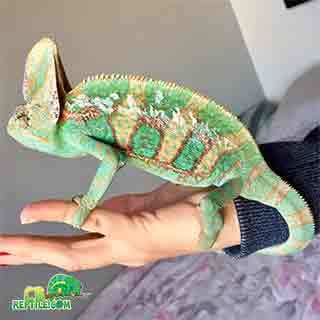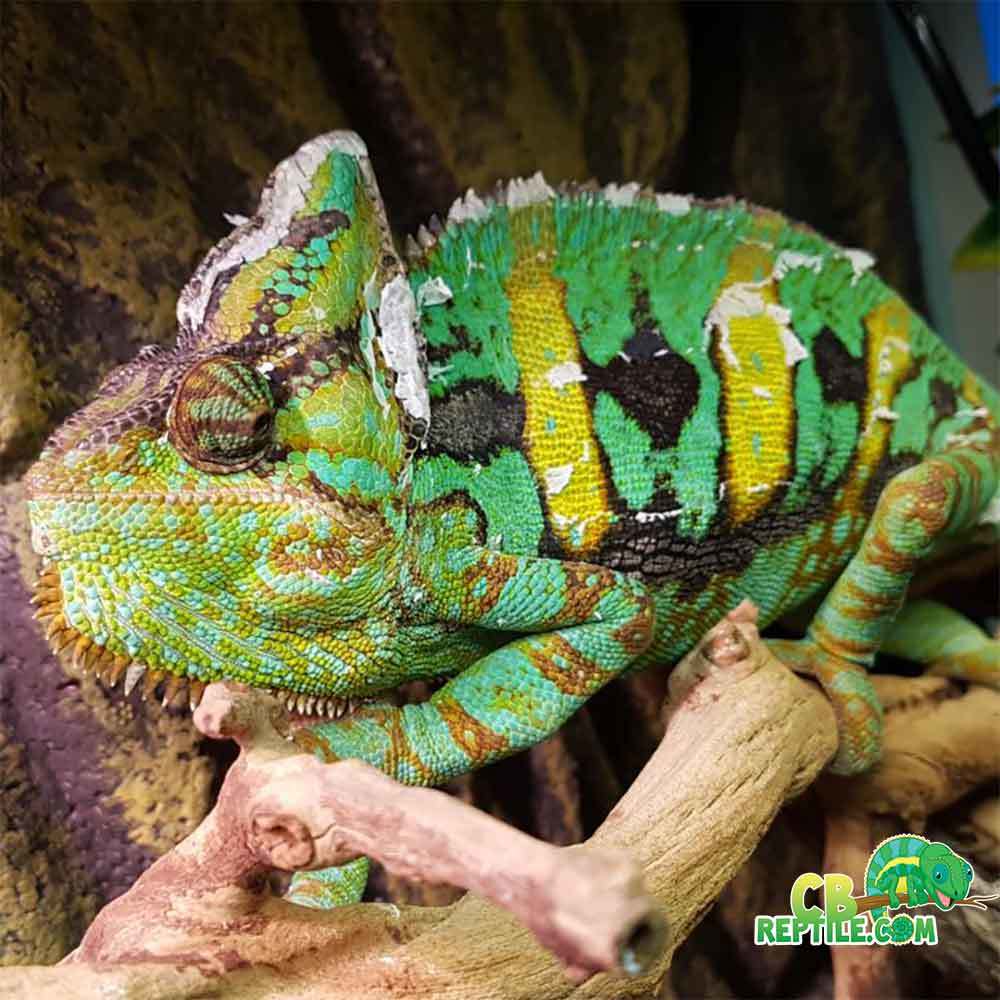How to Breed Veiled Chameleons: Egg Incubation & Hatchling Care

Before Eggs: Healthy Parents & Timing

Healthy breeding starts long before the first egg, bredren. Ensure both male and female are robust, well-hydrated, parasite-free, and mature. Offer a balanced diet (varied feeders, proper gutload), consistent UVB, and appropriate supplementation. Once a female is receptive and cycles successfully post-pairing, she’ll show behavioral cues—restlessness, digging attempts, and a shifting appetite—that tell you it’s time to prep the lay bin.
Laying Bin Setup
Give the queen her castle to dig, mon. A proper lay site prevents egg binding and stress:
- Container: A 12–14 inch (30–36 cm) deep bin with escape-proof sides. Place it inside her enclosure or in a secure lay chamber.
- Medium: Washed play sand alone, or a 50/50 sand and organic topsoil blend. Hydrate so it clumps when squeezed but never drips.
- Privacy: Visual barriers calm the vibe. Minimize foot traffic and bright lights while she digs.
- Hydration: Maintain normal misting for the enclosure, but don’t oversaturate the lay medium.
When she finishes, she’ll backfill the tunnel. Offer a long misting session and calcium-rich feeder or two to replenish her reserves.
Collecting Eggs Gently
After she refills the tunnel and settles, carefully excavate along the track to the chamber. Use fingers, not tools, to avoid cracking shells.
- Mark the top: As each egg appears, gently mark the uppermost side with a pencil. Keep that mark facing up at all times—don’t rotate, mon.
- Cull slugs: Remove clearly infertile eggs (soft, yellow, or collapsed) to reduce mold risk.
- Record: Note the female, pairing date, lay date, clutch count, and any standout details for clean data later.
Incubation Containers & Medium
Veiled chameleon eggs incubate well in ventilated plastic containers. Some keepers use sealed cups with tiny pinholes; others prefer more airflow. Consistency is the key, mon.
- Media choices: Vermiculite, perlite, or a 1:1 mix. Commercial substrates like HatchRite also work.
- Moisture target: Classic 1:1 by weight (water:vermiculite). If mixing by volume, go lighter on water and test for a firm, non-dripping clump.
- Placement: Nestle eggs half-buried or in shallow divots so they don’t roll. Space them to slow mold spread if any egg turns.
- Humidity: A light sheen or condensation on the lid is normal. If droplets rain on eggs, dab the lid and slightly reduce moisture.
Incubation Temperature & Duration
Steady temperature makes smooth sailing, bredren. Big swings stress embryos and lengthen the ride.
- Target range: 24–28 °C (75–82 °F).
- Sweet spot: Many veiled keepers favor 26–27 °C (78–80 °F) for steady development.
- Timeline: Expect roughly 6–9 months. Cooler temps lengthen incubation; warmer speeds it up within safe limits.
- Monitoring: Place a reliable digital probe in the incubator and, ideally, inside a test container to see the real internal temp. Data loggers make the vibes scientific and stress-free.
Check monthly for moisture and mold. Resist the urge to open containers daily—stability is king, mon.
Candling, Pre-Hatch Signs & Pipping
A small flashlight reveals veining in fertile eggs after a few weeks. Don’t over-candle; a quick peek is enough. Late in incubation, you may see “sweating” (surface moisture), slight denting, or subtle shell changes that signal the hatch window is near.
- Pipping: Hatchlings slit the shell with an egg tooth and may rest with their heads out. Don’t pull them—let them absorb that last yolk, mon.
- Assistance: Only intervene if an egg is clearly failing and you know what you’re doing. Patience brings better outcomes than rushed hands.
Hatchling Housing: Airy, Safe, and Simple

Once babies emerge, move them to a nursery built for tiny climbers. Good airflow, safe foliage, and easy water access are essential.
- Enclosures: Small screen or hybrid setups—think 12×12×18 in. for groups or smaller bins with ample branches for singles.
- Perches & plants: Fine branches and sturdy live plants like pothos, schefflera, or ficus to create cover and microclimates.
- UVB: Linear T5 HO 5.0 (or equivalent). Provide basking access and shaded zones so babies self-regulate.
- Basking temp: Gentle spot around 28–29 °C (82–85 °F) with cooler perches to avoid overheating.
- Humidity: Baseline ~50–70% with daily rise-and-fall. Allow dry-out between mistings to keep lungs happy.
Hydration: Mist Like Morning Rain
Hatchlings drink from droplets, not bowls. Offer light misting morning and evening so leaves bead up with tiny sips. A slow dripper over foliage helps shy drinkers. Ensure surfaces dry later to maintain crisp air—balance the dew with the breeze, mon.
Feeding: Tiny Bites, Big Nutrition
Veiled chameleon hatchlings thrive on small, frequent meals and clean supplements. Variety keeps the appetite lively and growth steady.
- Starter feeders: Flightless fruit flies (Drosophila melanogaster, then hydei), pinhead to 1/8″ crickets, bean beetle larvae, and small roaches of the right size.
- Frequency: 1–2 feedings per day early on. Don’t flood the nursery—offer what they’ll chase and finish.
- Supplements: Light dusting with plain calcium most feedings; calcium with D3 and a multivitamin on a conservative schedule (e.g., every 1–2 weeks), adjusted to your UVB strength and vet guidance.
- Gutload: Dark leafy greens, squash, sweet potato, bee pollen, quality commercial gutloads. What goes into your feeders flows into your babies, mon.
Group Dynamics & Separation
Veiled chameleons are solitary by nature. Some keepers start tiny groups in a larger nursery to keep feeders close, but watch for stress—gaping, color darkening, chasing, or weight stalls. At the first sign of competition or nipping, separate. More perches, more visual barriers, and ample food all reduce friction, but independence is the long-term plan.
Health Checks, Records & Cleanliness
- Daily: Monitor posture, color, appetite, and hydration (urates off-white to pale yellow).
- Weekly: Weigh to confirm steady gains—numbers reveal what eyes can miss.
- Sanitation: Spot clean daily; do scheduled wipe-downs with reptile-safe cleaners. Fresh air plus clean perches equals happy lungs.
- Vet connection: Work with a qualified reptile veterinarian for fecal checks and guidance as babies grow.
Why Experience Matters
Breeding veiled chameleons rewards a keeper who respects the rhythm—steady temps, measured moisture, sharp husbandry. That’s why tapping seasoned breeders saves time and heartache. CB Reptile has been a trusted name in the chameleon world for almost two decades, bringing well-started, captive-bred animals and clear care support so your project rolls irie from egg to adult.
When you’re browsing for a healthy chameleon for sale, look for transparent husbandry, strong lineage, and ethical practices. Your future clutches—and the animals themselves—deserve that good energy, mon.
